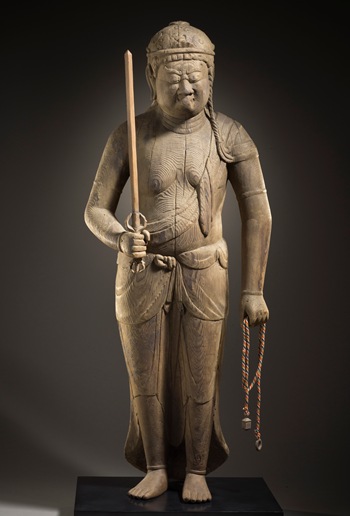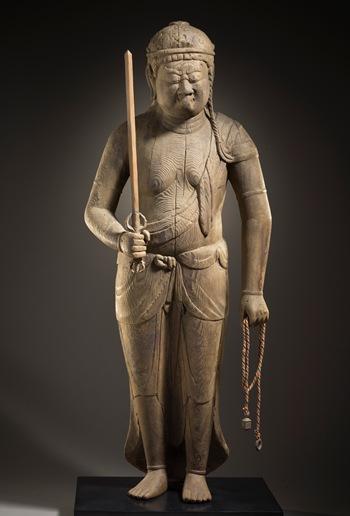Fudō Myōō is known as the Indomitable Foe of Evil in the Buddhist pantheon. Literally, his name means The Undefeatable Enlightened King of Buddhism. In the face of evil and falsehood, he is unyielding, unbeatable, indefatigable, and immovable. Created in circa 1125 by a master of Buddhist sculpture, Fudō is carved from one solid block of rare Zelkova wood. He holds a sword to cut through illusion and a rope to bind up devils and demons. Amazingly, the arms, hands, and hair braid are all original and unrestored, as can be easily proved by examining the unbroken fine wood grain across the sculpture, down to the tips of the fingers on each hand.

Fudō Myōō: The Indomitable Foe of Evil, Japan, c. 1125, purchased with funds provided by Irene Christopher, Scott M. Delman, and the 2012 Collectors Committee
In Japan, it is extremely rare that a previously unknown and unrecorded twelfth-century wood sculpture comes to light, as this one has in the last year. This has led to speculation by the leading scholars of Japanese Buddhist art that this remarkable image was long hidden away as a “Secret Buddha” (Hibutsu) in an enclosed shrine, which would explain its astonishing condition as well as its unknown provenance. Such Hibutsu are hidden from sight, and light, by virtue of the sacred enclosure in which they are enshrined. Depending on the particular temple for which it was made, a Hibutsu may be shown to temple visitors once a year, once a decade, once a century, or never shown at all! Fight fire with fire/fight evil with force: that is the message of Fudō’s fierce visage. Fudō is a powerful protective deity, and every painting and sculpture of him share these traits. From the front he is all power and strength, but from the back our Fudō shows a more feminine side—a softer, gentler stance, with flowing tresses. This is the yin-yang of masculine/feminine, force/gentleness, so deeply rooted in East Asian philosophy and art. LACMA has three magnificent wood sculptures of the twelfth century or earlier—all three of these sculptures have a peaceful countenance in line with their gentler roles in the Buddhist pantheon. This Fudō is the first Japanese Buddhist sculpture at LACMA to show a fierce, protective appearance in line with his role as a foe of evil. Now in Los Angeles, he will surely defend us in the constant battle against evil in the world. Robert T. Singer, curator and department head, Japanese art



